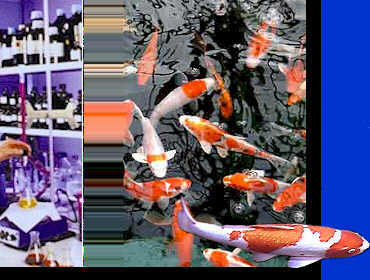|
|
Fish Skin Disorders
|
Symptoms
|
|
Cause
|
|
Treatment and Links
|
| A). With a magnifying glass, you can see red
dots on the fish, or you can see transparent disc shaped
crustaceans |
 |
Your fish are affected with fish lice |
 |
Treat with
De-Los. |
 |
|
 |
|
|
| B). Elongated oval objects measuring up to 10mm,
stick up out of the skin |
 |
This involves the egg pouches of copepods, e.g.
Lernaea. The anterior portion of the parasite is burrowed
deeper into the skin |
 |
Treat with
De-Los. |
 |
|
| C). Round reddish enflamed areas, 38mm in
diameter, are visible on the skin |
 |
These are sucking marks made by leeches, which
often attack the fish only at night, then hide during the day |
 |
Treat with
De-Los. |
 |
|
| D). Small, dark, knot-like thickened areas, up
to 1mm in size appear on the skin |
 |
Encapsulated metacercariae (larvae) are often
found on fish caught in the wild |
 |
Fish can live to a ripe old age, despite the
condition. No treatment is needed. |
 |
|
| E). The fish appear to be sprinkled with sand or
grit. The lumps are white, about 0.5 to 1.5mm in size.
The skin comes off in shreds |
 |
a). In the case of freshwater fish,
they are affected by the protozoan Ichthyophthirius (Ich).
b). Marine fish are affected by Cryptocaryon Irritans |
 |
Use: a).
Malachite Green -or-
Forma-Green. b). Treat the fish with
Copper Sulfate. -or- Quinine Sulfate |
 |
|
| F). Clearly delineated, whitish, translucent
areas measuring 1 to 3mm appear on the skin. Often visible
only from a head-on view |
 |
Your fish are affected by the protozoan ciliate
Chilodonella |
 |
Treat your fish with
Metronidazole -or-
Malachite Green -or-
Forma-Green. |
 |
|
| G). In marine fish, heavy slime production,
along with loss of appetite, lethargy and labored breathing.
In the terminal stage, skin slabs come off |
 |
Your fish are affected with Brooklynella
Hostilis |
 |
Use:
Malachite Green -or-
Forma-Green. -or- Quinine Sulfate |
 |
|
| H). Tiny, dirty-whitish to yellowish dots up to
0.3mm in size appear on the skin and scale edges |
 |
Your fish are affected with Oodinium |
 |
Use:
Malachite Green -or-
Forma-Green. -or- Quinine Sulfate |
 |
|
| I). The skin clouds up in some areas, then comes
off, leaving bloody patches |
 |
Your fish are affected by a heavy Costia
infection |
 |
Use: Forma-Green
-or-
Acriflavine Neutral -or-
Copper Sulfate. |
 |
|
| J). Whitish translucent areas, not caused by
slime form on the skin |
 |
The fish are probably affected by Sporozoa |
 |
No suitable treatment known.
Furazolidone Powder
helps in rare cases. |
 |
|
| K). The skin, cloudy and inflamed in places,
produces a great deal of slime |
 |
Does the pH satisfy the needs of the fish?
The skin is either infected with Parasites or Bacteria |
 |
Treat with:
Parinox |
 |
|
 |
|
|
| |
|
Extreme fluctuations in pH, lead to
slime production in the skin. |
 |
Adjust the pH by doing a water
change. |
|
| L). White threads grow out of white and red
edged wounds, and form cottony puffs |
 |
Fungus is infecting the wound |
 |
Treat with:
Malachite Green
-or-
Forma-Green
-or-
Nitrofuracin Green |
 |
|
| M). A whitish film forms around the mouth of one
or more of the fish |
 |
Your fish are affected with Columnaris |
 |
Treat with:
TMP Sulfa -or-
Sulfa 4 TMP -or-
Parinox. |
 |
|
| O). The scales in many places are outlined in
white. The skin easily becomes slimy. The fish folds
it's fins and sways |
 |
Sounds like your fish have a heavy infection of
Columnaris. |
 |
Treat with:
TMP Sulfa -or-
Sulfa 4 TMP -or-
Parinox. |
 |
|
| P). Redbordered lesions in the skin. They
often clear up spontaneously |
 |
The lesions rupture, releasing a liquid.
Your fish are affected by Furunculosis |
 |
Treat with:
Furazolidone Powder |
 |
|
 |
|
|
| |
|
Lesions rupture, but nothing is released.
Your fish are affected by open Tuberculosis. Warning: This
disease can be spread to humans. Do not put your hands or
arms in the tank if you have cuts or open sores on them. |
 |
Treat with:
Kanamycin + Vitamin B-6. Treat for up to 30 days.
Isolate this fish and treat them for 30 days. |
|
| Q). A swelling forms in the muscle under the
skin during the course of several weeks and may protrude way out
from the surface of the body. The scales can be lifted
also |
 |
A sporozoan cyst or lesion forms in the
musculature |
 |
No suitable treatment known. Verify by
dissecting the fish. |
 |
|
| R). Blisters form along the lateral line.
Often associated with bloat, spread scales and popeyes |
 |
Your fish are affected by Abdominal Dropsy. |
 |
Treat with Koi Fix®,
or a combination of
Oxolinic Acid and
Oxytetracycline
in the feed at 1 tsp. per pound each. Use
Forma Green in the water if the fish has ulcerations. |
 |
|
| S). Light colored spherical prominences which
look like eggs but cannot be wiped off, form on the skin |
 |
Your fish are affected by the Lymphocystis virus |
 |
No suitable treatment known. |
 |
|
| T). Variously sized blisters which form on the
skin pop when stroked, producing a crackling sound |
 |
Your fish are affected by a swim bladder disease |
 |
Make sure fish is aerated sufficiently.
Treat with Erythromycin -or-
Quinine Sulfate. |
 |
|
| U). One fish, or many fish appear to have red
streaking through the body and/or fins |
 |
Your fish are affected by Bacterial hemmorrhagic
septicemia |
 |
Treat the fish with:
Doxycycline -or-Oxytetracycline. |
| |
|
Home
ı
Articles ı
Prevention ı
Fish
Diseases ı
About Us ı
Contact Us ı
Terms of Use ı
Privacy Policy ı
Shipping ı
Products |

